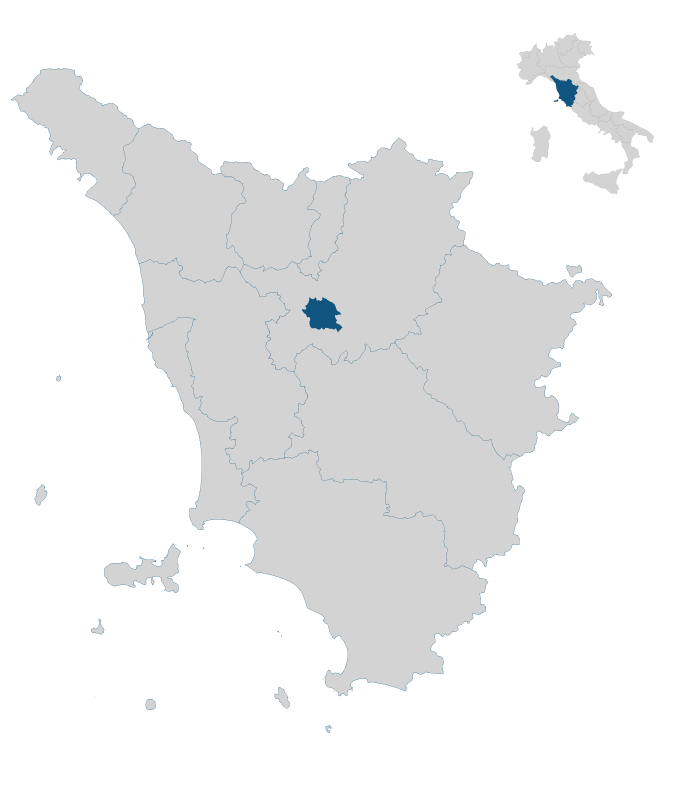Montegufoni Castle
From medieval castle to villa degli Acciaoli. The exciting story of a place that has preserved the masterpieces of the Uffizi
Throughout its millenary history, we can identify three different configurations for the Montegufoni castle.
1 – The medieval castle (11th-12th century)
It was a fortified structure with one or more towers, with an enviable position on the road that led from Florence to Volterra. The Ormanni, who were the owners, soon realized that they could have benefited more from people in transit on the Volterrana than from agriculture, thus starting to impose tolls on travelers and pilgrims.
Of the ancient Ormanni manor, today only the ruins of a circular tower remain, visible on the left of the ramp leading up to the castle.
2 – The castle of “ladies’ houses” of the Acciaioli (13th-16th centuries)
In 1160, a certain Guglierallo Acciaioli settled in Tuscany, who fled from Brescia following the descent into Italy of the Emperor Federico Barbarossa. Acciaioli bought some houses in Florence and a lot of land in the Montespertoli area, including the ruins of the destroyed castle of Montegufoni.
In Florence the Acciaioli engaged in politics in the ranks of the Guelph party, succeeding in affirming and enriching themselves with the activity of bankers, thanks to Leone, who had founded the Banco Acciaioli, with which he lent money, even to many sovereigns of ‘Europe. At the end of the 13th century, Leone Acciaioli and his brothers Loteringo and Guidalotto built three “gentlemen’s houses” in Montegufoni, each on its own and one next to the other. Their example was then followed by their cousin Bartolomeo, so that around a central square a small village was formed, completely enclosed by walls, which was still given the castle of Montegufoni, even though it no longer had the characteristics of a medieval manor.
3 – The Villa of the Marquises Acciaioli (17th-19th centuries)
Due to a series of circumstances, even fortunate, in 1659 the seven houses of the lords of Montegufoni and the large estate of 18 farms all became the property of Donato di Ottaviano Acciaioli, who, having also acquired greater dignity with the appointment as senator, he thought well of transforming that messy cluster of houses into a stately villa, capable of rivaling on a par with the residences of the main Florentine families. Perhaps following a design idea, developed years earlier by the Florentine architect Gherardo Silvani on behalf of their father Ottaviano Acciaioli, it was Donato himself and his brother, Cardinal Nicola, who carried out the works, which lasted for almost forty years. But the historical events of the end of the century wiped out this world forever and, perhaps also for this reason, a long period of economic crisis began for the Acciaioli, culminating in 1823 with the sale of the castle.
In 1909, the castle was bought by Sir George Sitwell, a wealthy Englishman, who began a long restoration work completed in the late 1930s, thanks to which the castle returned to take on the appearance we still see today. In 1922, Sir George Sitwell commissioned the Cubist painter Gino Severini to fresco a small room on the upper floor (Sala delle Maschere) with the characters of the Commedia dell’Arte. During the Second World War the Montegufoni castle was used as a deposit for 272 works of art from Florentine museums to save them from the danger of bombing the city. Among them “La Primavera” by Botticelli, the three Majesties by Giotto, Cimabue and Duccio da Boninsegna. In 1972, the castle was bought by the current owners, who made it a welcoming and prestigious accommodation facility.
A small gallery
Contacts
Montegufoni Castle
Via Montegufoni, 18 - Montagnana VP
50025 Montespertoli (Florence)
+39 0571 671131
info@montegufoni.it
Map
In the heart of Tuscany

